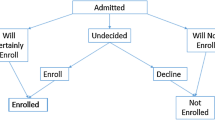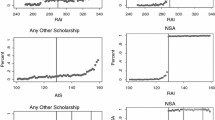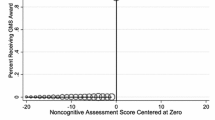Abstract
Twenty-one US states currently offer some form of merit-based postsecondary financial aid, although the generosity and eligibility requirements of merit aid programs varies from state to state. This article uses nationally representative data from high school students in the early 1990s and the early 2000s to evaluate the relationship between the design of merit aid programs and their effects on student achievement and college trajectories. The findings suggest that programs that guarantee full tuition to recipients have greater effects on students’ high school course-taking and college choice than less generous programs. Further, I find provisional evidence to suggest that programs with relatively simple merit-based eligibility requirements are more effective than programs with more complex means-tested eligibility requirements.
Similar content being viewed by others
Notes
In most merit aid programs, scholarships are renewable for up to 4 years, as long as recipients remain enrolled in college full-time and earn a minimum GPA. In Michigan, however, merit aid is allocated in a one-year lump sum.
As an example, between 1990 and 1992, 12th grade NAEP math scores increased by 4.7 scale points in states that never implemented merit aid. In that same pre-policy period, NAEP math scores increased by 4.9 scale points in states that implemented full-tuition merit aid programs between 1992 and 2004.
Massachusetts also falls in this category, but is not included in the analyses since its aid program came online after ELS students graduated high school. Massachusetts is the only US state that awards aid exclusively on the basis of test scores.
Arkansas also falls in this category, but is not included in the analyses.
Although both the NELS and ELS also administered standardized tests of reading ability in the 10th grade, these measures are not available in the 12th grade.
The ELS college enrollment data is available to researchers via a restricted-use data license. In compliance with NCES restricted-use data requirements, the number of cases in analyses of these data are rounded to the nearest 10.
Since relatively few students in either cohort enrolled private colleges, I was unable to study the effects of merit aid programs implementation on students’ odds of enrolling in in-state private universities. This is unfortunate, since many merit aid programs provide smaller tuition subsidies for these institutions.
References
Advisory Committee on Student Financial Assistance. (2002). Empty Promises: The Myth of College Access in America. Washington, DC. Retrieved May 1, 2013 from: https://www2.ed.gov/about/bdscomm/list/acsfa/emptypromises.pdf.
Attewell, P., & Domina, T. (2008). Raising the bar: Curricular intensity and academic performance. Educational Evaluation and Policy Analysis, 30(1), 51–71.
Becker, G. S. (1994). Human capital: A theoretical and empirical analysis, with special reference to education. Chicago: University of Chicago Press.
Binder, M., & Ganderton, P. T. (2004). The New Mexico lottery scholarship: Does it help minority and low-income students? In D. E. Heller & P. Marin (Eds.), State merit scholarship programs and racial inequality (pp. 101–122). Cambridge, MA: The Civil Rights Project at Harvard University.
College Board. (2002). Trends in college pricing. Washington, DC: College Board Advocacy and Policy Center.
College Board. (2011). Cracking the Student Aid Code: Parent and Student Perspectives on Paying for College. Washington, DC. Retreived May 1, 2013 from: http://advocacy.collegeboard.org/sites/default/files/11b_3172_Cracking_Code_Update_WEB_110112.pdf.
Cornwell, C., Lee, K. H., & Mustard, D. B. (2005). Student responses to merit scholarship retention rules. The Journal of Human Resources, 40(4), 895–917.
Cornwell, C., Mustard, D. B. (2006). “Merit aid and sorting: The effects of HOPE-style Scholarships on College Ability Stratificiation.” IZA Discussion Paper No. 1956.
Cornwell, C., Mustard, D. B. (2006). The Cornwell-Mustard HOPE Scholarship Page: Other Merit-Aid Programs. Retrieved November 19, 2009 from http://www.terry.uga.edu/hope/other.html.
Cornwell, C., Mustard, D. B., & Sridhar, D. J. (2006). The enrollment effects of merit-based financial aid: Evidence from Georgia’s HOPE program. Journal of Labor Economics, 24(4), 761–786.
Curtin, T. R., Ingels, S. J., Wu, S., & Heuer, R. (2002). NELS: 88 base year to fourth followup data file user’s manual (NCES 2002–323). US Department of Education. National Center for Education Statistics. Washington, DC: US Government Printing Office.
Delaney, J. A., & Ness, E. C. (2013). Creating a merit aid typology. In B. Curs (Ed.), Merit aid reconsidered, new directions in institutional research. San Francisco: Jossey-Bass.
DesJardins, S., & Toutkoushian, R. (2005). Are students really rational? The development of rational thought and its application to student choice (pp. 191–240). Higher education: Handbook of theory and research.
Domina, T., Conley, A., & Farkas, G. (2011). The link between educational expectations and effort in the college-for-all era. Sociology of Education, 84(2), 93–112.
Domina, T., & Saldana, J. (2012). Does raising the bar level the playing field? Mathematics curricular intensification and inequality in American high schools, 1982–2004. American Educational Research Journal, 49(4), 685–708.
Doyle, W. R. (2006). Adoption of merit-based student grant programs: An event history analysis. Educational Evaluation and Policy Analysis, 28(3), 259–285.
Dynarski, S. (2002). Race, income, and the impact of merit aid. In D. E. Heller & P. Marin (Eds.), Who should we help? The negative social consequences of merit scholarships (pp. 73–92). Cambridge, MA: The Civil Rights Project at Harvard University.
Dynarski, S. (2004). The new merit aid. In C. Hoxby (Ed.), College choices: The economics of where to go, when to go, and how to pay for it (pp. 63–97). Chicago: University of Chicago Press.
Goodman, J. (2008). Who merits financial aid: Massachusetts’ Adams scholarship. Journal of Public Economics, 92, 2121–2131.
Goyette, K. A. (2008). College for some to college for all: Social background, occupational expectations, and educational expectations over time. Social Science Research, 37, 461–484.
Grodsky, E., & Jones, M. T. (2007). Real and imagined barriers to college entry: Perceptions of cost. Social Science Research, 36(2), 745–766.
Heller, D. E. (2004). State merit scholarship programs: An overview. In D. E. Heller & P. Marin (Eds.), State merit scholarship programs and racial inequality (pp. 23–46). Cambridge, MA: The Civil Rights Project at Harvard University.
Henry, G. T., & Rubenstein, R. (2002). Paying for grades: Impact of merit-based financial aid on educational quality. Journal of Policy Analysis and Management, 21(1), 93–109.
Henry, G. T., Rubenstein, R., & Bugler, D. T. (2004). Is HOPE enough? Impacts of receiving and losing merit-based financial aid. Educational Policy, 18(5), 686–709.
Horn, L., Chen, X., & Chapman, C. (2003). Getting ready to pay for college (p. 30). US Department of Education/Institute of Education Sciences: NCES.
Hossler, D., & Gallagher, K. S. (1987). Studying student college choice: A three-phase model and the implications for policymakers. College and University, 62(3), 207–221.
Hu, S., Trengove, M., & Zhang, L. (2012). Toward a greater understanding of the effects of state merit aid programs: examining existing evidence and exploring future research direction. In J. C. Smart & M. B. Paulsen (Eds.), Higher education: Handbook of theory and research (pp. 291–334). New York: Springer.
Ingels, S. J., Dalton, B. W., & LoGerfo, L. (2008). Trends among high school seniors, 1972–2004. NCES 2008–320. Washington, DC: National Center for Education Statistics.
John, E. P., & Chung, C. (2004). Merit and equity: Rethinking award criteria in the Michigan Merit Scholarship Program. In E. P. John & M. D. Parsons (Eds.), Public funding of higher education (pp. 124–140). Baltimore: Johns Hopkins University Press.
Kane, T. J. (2003.) A Quasi-Experimental Estimate of the Impact of Financial Aid on College-Going. NBER Working paper. Retrieved November 19, 2009 from http://ideas.repec.org/p/nbr/nberwo/9703.html.
Kelley, D. (1996). HOPE for a free education: Plan keeps bright students in state. USA Today, 1996, 8B.
Kirst, M., & Venezia, A. (2001). Bridging the great divide between secondary schools and postsecondary education. The Phi Delta Kappan, 83(1), 92–97.
Krueger, C. (2005). Merit scholarships. Denver, Co: Education of Commission of the States. Retrieved November 13, 2009 from http://www.ecs.org/clearinghouse/61/40/6140.pdf.
Long, B. T. (2004). Does the format of a financial aid program matter? The effect of state in-kind tuition subsidies. The Review of Economics and Statistics, 86(3), 767–782.
Manski, C. F., & Wise, D. A. (1983). College choice in America. Cambridge: Harvard University Press.
Morgan, S. L. (2005). On the edge of commitment: Educational attainment and race in the United States. Stanford: Stanford University Press.
National Association of State Student Grant and Aid Programs. (2007). 37th Annual Survey Report on State-Sponsored Student Financial Aid, 2005–2006 Academic Year.
Ness, E. C. (2008). Merit aid and the politics of education. New York: Routledge.
Ness, E. C., & Noland, B. E. (2007). Targeted merit aid: Tennessee education lottery scholarship program. Journal of Student Financial Aid, 37, 7–17.
Ness, E. C., & Tucker, R. (2008). Eligibility effects on college access: Under-represented student perceptions of Tennessee’s merit aid program. Research in Higher Education, 49, 569–588.
Pallais, A. (2009). Taking a chance on college: Is the Tennessee education lottery scholarship program a winner? The Journal of Human Resources, 44(1), 199–221.
Perna, L. W. (2000). Differences in the decision to attend college among African Americans, Hispanics, and Whites. Journal of Higher Education, 71, 117–141.
Perna, L. W. (2006). Studying college access and choice: A proposed conceptual model. In J. Smart & M. Paulsen (Eds.), Higher education (pp. 99–157). Netherlands: Springer.
Perna, L. W., & Steele, P. E. (2011). The role of context in understanding the contributions of financial aid to college opportunity. Teachers College Record, 113(5), 895–933.
Rosenbaum, J. E. (2001). Beyond college for all: Career paths for the forgotten half. New York: Russell Sage Foundation Publications.
Royston, P. (2004). Multiple imputation of missing values. Stata Journal, 4(3), 227–241.
Royston, P. (2005a). Multiple imputation of missing values: Update. Stata Journal, 5, 188–201.
Royston, P. (2005b). Multiple imputation of missing values: Update of ice. Stata Journal, 5, 527–536.
Scott-Clayton, J. (2008). On money and motivation: A quasi-experimental analysis of financial incentives for college achievement. Working Paper, Harvard Graduate School of Education.
Singell, L. D., Waddell, G. R., & Curs, B. R. (2006). HOPE for the Pell? Institutional effects in the intersection of merit-based and need-based aid. Southern Economic Journal, 73(1), 79–99.
Toutkoushian, R. K., & Hillman, N. W. (2012). The impact of state appropriations and Grants on access to higher education and outmigration. The Review of Higher Education, 36(1), 51–90.
Venezia, A., Kirst, M., & Antonio, A. L. (2003). Betraying the college dream. The Bridge Project Stanford Institute for Higher Education, 2–12.
Washington State Higher Education Coordinating Board. (1992). Tuition and Fee Rates: A National Comparison.
Washington State Higher Education Coordinating Board. (2004). Tuition and Fee Rates: A National Comparison.
Zhang, L. (2011). Does merit-based aid affect degree production in STEM Fields?: Evidence from Georgia and Florida. The Journal of Higher Education, 82(4), 389–415.
Zhang, L., & Ness, E. C. (2010). Does state merit-based aid stem brain drain? Educational Evaluation and Policy Analysis, 32(2), 143–165.
Author information
Authors and Affiliations
Corresponding author
Rights and permissions
About this article
Cite this article
Domina, T. Does Merit Aid Program Design Matter? A Cross-Cohort Analysis. Res High Educ 55, 1–26 (2014). https://doi.org/10.1007/s11162-013-9302-y
Received:
Published:
Issue Date:
DOI: https://doi.org/10.1007/s11162-013-9302-y




